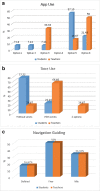VR4Health: Personalized teaching and learning anatomy using VR
- PMID: 32193612
- PMCID: PMC7082407
- DOI: 10.1007/s10916-020-01550-5
VR4Health: Personalized teaching and learning anatomy using VR
Abstract
Virtual Reality (VR) is being integrated into many different areas of our lives, from industrial engineering to video-games, and also including teaching and education. We have several examples where VR has been used to engage students and facilitate their 3D spatial understanding, but can VR help also teachers? What are the benefits teachers can obtain on using VR applications? In this paper we present an application (VR4Health) designed to allow students to directly inspect 3D models of several human organs by using Virtual Reality systems. The application is designed to be used in an HMD device autonomously as a self-learning tool and also reports information to teachers in order that he/she becomes aware of what the students do and can redirect his/her work to the concrete necessities of the student. We evaluate both the students' and the teachers' perception by doing an experiment and asking them to fill-in a questionnaire at the end of the experiment.
Keywords: Health sciences; Nursing; Self-learning; Virtual reality.
Conflict of interest statement
The authors declare that they have no conflict of interests.
Figures




Similar articles
-
The effectiveness of virtual and augmented reality in health sciences and medical anatomy.Anat Sci Educ. 2017 Nov;10(6):549-559. doi: 10.1002/ase.1696. Epub 2017 Apr 17. Anat Sci Educ. 2017. PMID: 28419750
-
Teaching and Curriculum of the Preschool Physical Education Major Direction in Colleges and Universities under Virtual Reality Technology.Comput Intell Neurosci. 2022 Mar 9;2022:3250986. doi: 10.1155/2022/3250986. eCollection 2022. Comput Intell Neurosci. 2022. PMID: 35310594 Free PMC article.
-
Three-dimensional Virtual Reality as an Innovative Teaching and Learning Tool for Human Anatomy Courses in Medical Education: A Mixed Methods Study.Cureus. 2020 Feb 24;12(2):e7085. doi: 10.7759/cureus.7085. Cureus. 2020. PMID: 32226686 Free PMC article.
-
The effectiveness of virtual reality-based technology on anatomy teaching: a meta-analysis of randomized controlled studies.BMC Med Educ. 2020 Apr 25;20(1):127. doi: 10.1186/s12909-020-1994-z. BMC Med Educ. 2020. PMID: 32334594 Free PMC article. Review.
-
Anatomy Visualizations Using Stereopsis: Assessment and Implication of Stereoscopic Virtual Models in Anatomical Education.Adv Exp Med Biol. 2020;1235:117-130. doi: 10.1007/978-3-030-37639-0_7. Adv Exp Med Biol. 2020. PMID: 32488639 Review.
Cited by
-
Comparison of cooperative learning through use of an immersive virtual reality anatomy model and a 3D plastic anatomical model.BMC Med Educ. 2025 May 30;25(1):807. doi: 10.1186/s12909-025-07397-z. BMC Med Educ. 2025. PMID: 40448126 Free PMC article.
-
Enhancing anatomy education with virtual reality: integrating three-dimensional models for improved learning efficiency and student satisfaction.Front Med (Lausanne). 2025 Jun 4;12:1555053. doi: 10.3389/fmed.2025.1555053. eCollection 2025. Front Med (Lausanne). 2025. PMID: 40534689 Free PMC article. Review.
-
Our education, our concerns: The impact on medical student education of COVID-19.Med Educ. 2020 Jul;54(7):591-592. doi: 10.1111/medu.14181. Epub 2020 May 23. Med Educ. 2020. PMID: 32310318 Free PMC article.
-
Determinants of Learning Anatomy in an Immersive Virtual Reality Environment - A Scoping Review.Med Sci Educ. 2022 Dec 22;33(1):287-297. doi: 10.1007/s40670-022-01701-y. eCollection 2023 Feb. Med Sci Educ. 2022. PMID: 36573211 Free PMC article.
-
The use of 3D video in medical education: A scoping review.Int J Nurs Sci. 2023 Jun 24;10(3):414-421. doi: 10.1016/j.ijnss.2023.06.006. eCollection 2023 Jul. Int J Nurs Sci. 2023. PMID: 37545776 Free PMC article.
References
-
- Azuma RT. A survey of augmented reality. Presence: Teleoper. Virt. Environ. 1997;6(4):355–385. doi: 10.1162/pres.1997.6.4.355. - DOI
-
- Bailenson J, Yee N, Blascovich J, Beall A, Lundblad N. The use of immersive virtual reality in the learning sciences: Digital transformations of teachers, students, and social context. Learn. Sci. 2008;17:102–141. doi: 10.1080/10508400701793141. - DOI
-
- Chittaro L, Ranon R. Web3d technologies in learning, education and training: Motivations, issues, opportunities. Comput. Educ. 2007;49(1):3–18. doi: 10.1016/j.compedu.2005.06.002. - DOI
-
- Fairén M., Farrés M., Moyés J., Insa E.: Virtual reality to teach anatomy. In: (Bourdin J.J., Shesh A., Eds.) EG 2017 - Education Papers. The Eurographics Association, 2017, 10.2312/eged.20171026
Publication types
MeSH terms
Grants and funding
LinkOut - more resources
Full Text Sources
Medical

